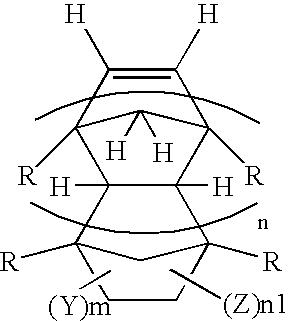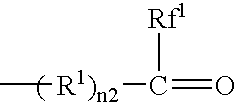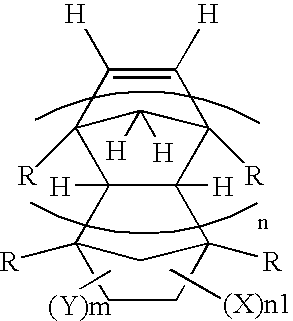Process for preparing fluorine-containing norbornene derivative
a technology of norbornene and derivatives, which is applied in the field of new norbornene derivatives, can solve the problems of not being able to form a pattern of fsub>2 /sub>resist, substantially difficult to use polymers as single layers of fsub>2 /sub>resist, and having a wavelength of 157 nm,
- Summary
- Abstract
- Description
- Claims
- Application Information
AI Technical Summary
Benefits of technology
Problems solved by technology
Method used
Image
Examples
preparation example 1
(Synthesis of Norbornene Having —COF Group)
[0577]A 500 ml four-necked glass flask equipped with a reflux condenser, thermometer, stirrer and dropping funnel was charged with 136 g of cyclopentadiene and 1.0 g of hydroquinone and was cooled to 0° to 5° C. Thereto was added dropwise 233 g of α-fluoroacrylic acid fluoride (CH2═CFCOF) over three hours in nitrogen gas stream. After completion of the addition, stirring was carried out for three hours at room temperature.
[0578]The reaction mixture was subjected to distillation under reduced pressure to obtain 360 g of 5-norbornene-2-carboxylic acid fluoride:
[0579]
[0580](melting point: 73° to 75° C. / 45 mmHg) which is a norbornene compound having —COF group (yield: 90%)
[0581]The above-mentioned structure of this compound was determined by GC-Mass, 19F-NMR and 1H-NMR analyses.
example 1
(Synthesis of (5-norbornene-2-yl)trifluoromethyl ketone)
[0582]A 100 ml three-necked flask equipped with a thermometer, cooling tube having a 3-way cock and dropping funnel was charged with 17 g (112 mmol) of 5-norbornene-2-carboxylic acid methyl ester (mixture of endo-form and exo-form) and 0.45 g (3 mmol) of cesium fluoride and was cooled in ice bath in nitrogen gas atmosphere. While maintaining the inside temperature of the flask at 3° to 10° C., 22 g (156 mmol) of CF3SiMe3 was added dropwise over two hours with stirring. After increasing the flask temperature to room temperature and stirring for three hours, 2 g (8 mmol) of tetrabutylammonium fluoride was added thereto and stirring was carried out for one hour. The reaction solution was poured into ice water, followed by extraction with diethylether. After drying an organic phase with calcium chloride, refining was carried out by distillation under reduced pressure and 12 g (yield: 56%, based on 5-norbornene-2-carboxylic acid met...
example 2
(Synthesis of (5-norbornene-2-yl)-1,1,1,3,3,3-hexafluoro-2-propanol (NB-1))
[0585]A 100 ml three-necked flask equipped with a thermometer, cooling tube having a 3-way cock and dropping funnel was charged with 12 g (64 mmol) of (5-norbornene-2-yl)trifluoromethyl ketone (mixture of endo-form and exo-form), 11 g (79 mmol) of CF3SiMe3 and 20 ml of THF and was cooled in dry ice / acetone bath in nitrogen gas atmosphere. While maintaining the inside temperature of the flask at −70° C. or lower, 3 ml (3 mmol) of 1M THF solution of tetrabutylammonium fluoride was added gradually with stirring. After increasing the flask temperature to room temperature and stirring for three hours, 20 ml of 5% hydrochloric acid was added thereto and stirring was further carried out for three hours. After extracting with diethylether and washing with a saturated aqueous solution of sodium hydrogencarbonate, an organic phase was dried with calcium chloride. After distilling off the solvent, refining was carried o...
PUM
 Login to View More
Login to View More Abstract
Description
Claims
Application Information
 Login to View More
Login to View More - R&D
- Intellectual Property
- Life Sciences
- Materials
- Tech Scout
- Unparalleled Data Quality
- Higher Quality Content
- 60% Fewer Hallucinations
Browse by: Latest US Patents, China's latest patents, Technical Efficacy Thesaurus, Application Domain, Technology Topic, Popular Technical Reports.
© 2025 PatSnap. All rights reserved.Legal|Privacy policy|Modern Slavery Act Transparency Statement|Sitemap|About US| Contact US: help@patsnap.com



